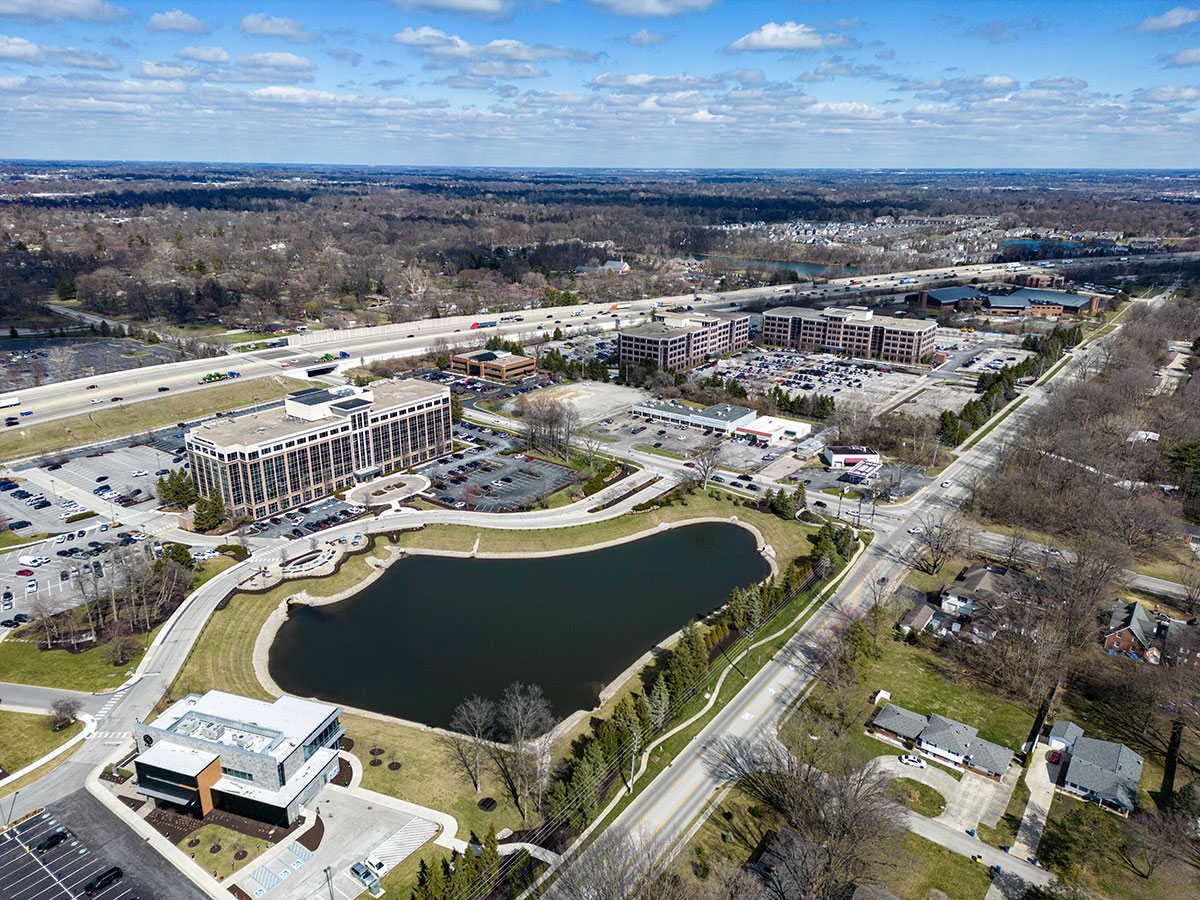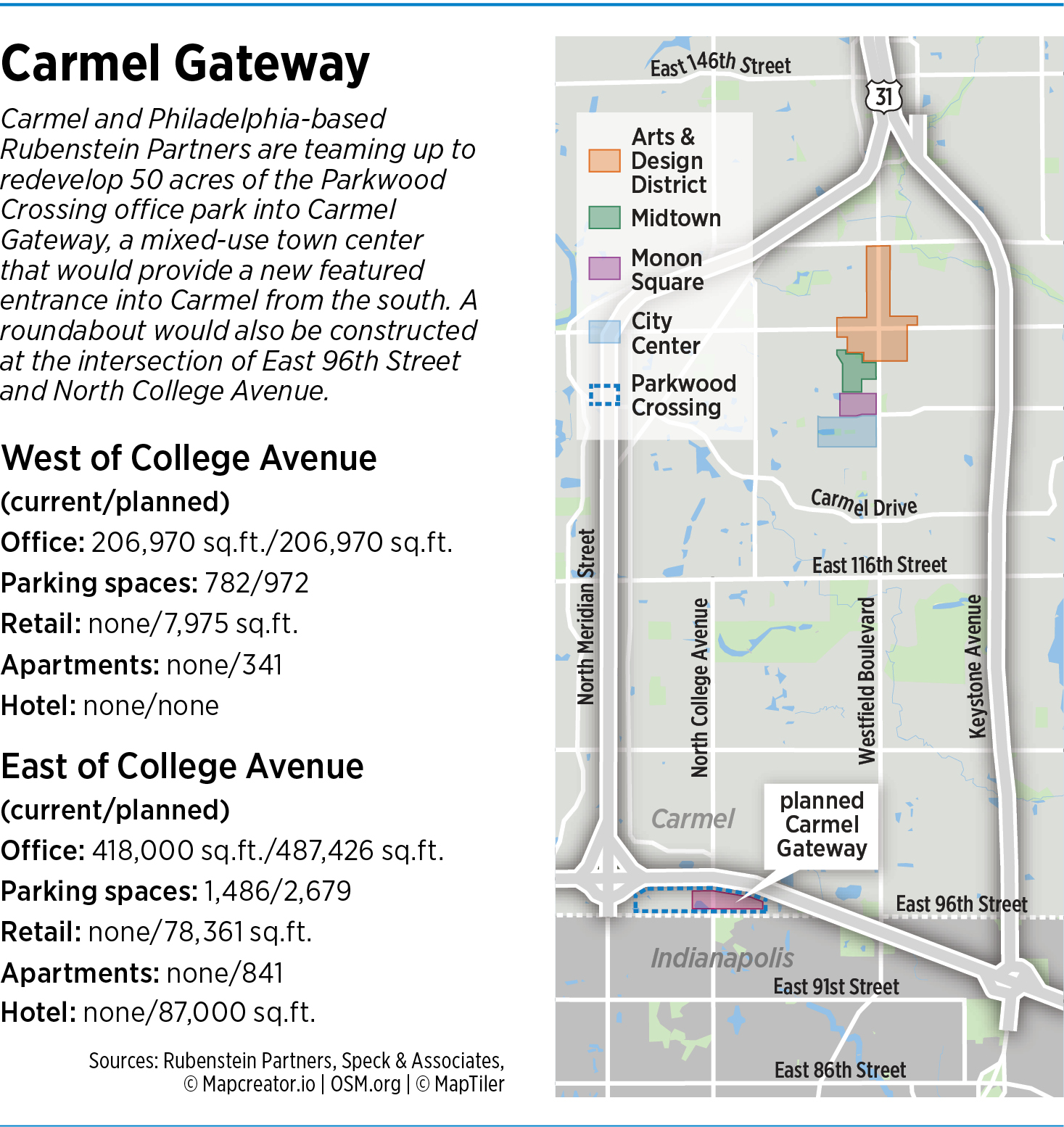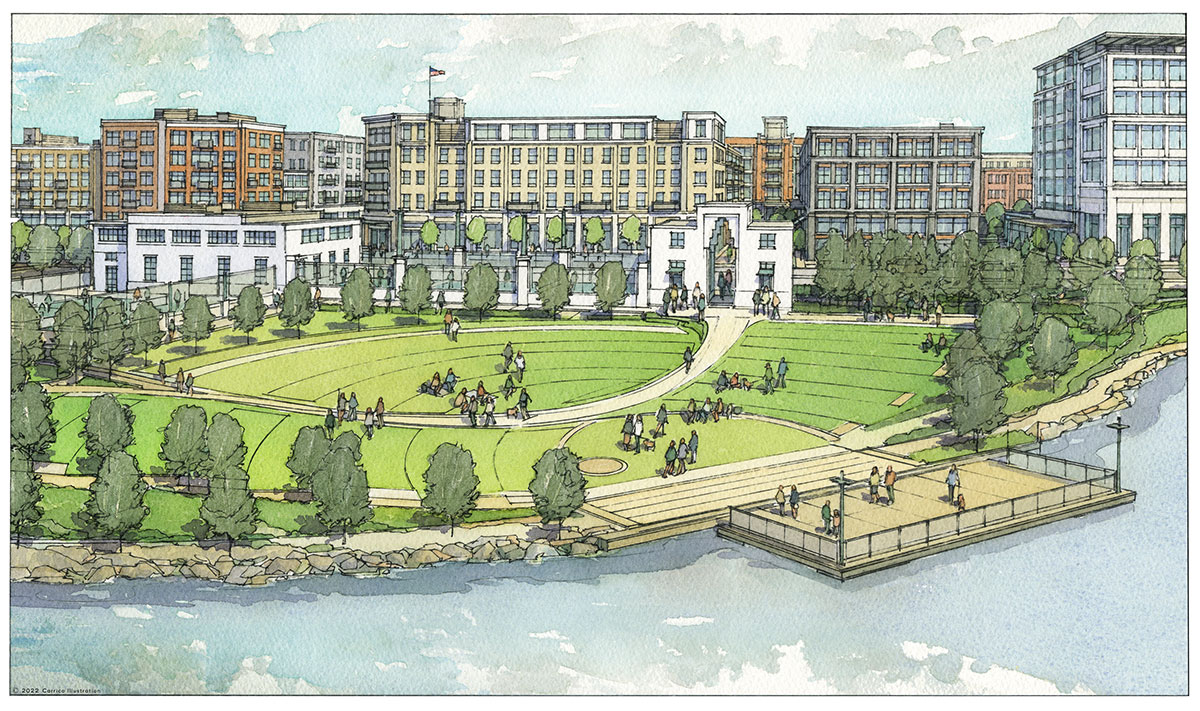Subscriber Benefit
As a subscriber you can listen to articles at work, in the car, or while you work out. Subscribe Now
Can a traditional office park be turned into a mixed-use town center? It’s rare, but it could happen in Carmel.
The city and Philadelphia-based Rubenstein Partners are developing plans to transform the eastern half of Parkwood Crossing into a neighborhood with office space, housing, restaurants, retail, recreation and a new street grid.
Parkwood Crossing—at North College Avenue, across Carmel’s 96th Street border with Indianapolis—is the largest office complex in the metropolitan area. It has eight multistory buildings, 1.2 million square feet of rentable office space and an occupancy rate of 76%, according to IBJ statistics.
The project called Carmel Gateway would incorporate Parkwood Crossing’s three largest office buildings, a large parking lot and a pond into a mixed-use development that would add 1.2 million square feet of housing with nearly 1,200 apartment units, more than 86,000 square feet of retail space and 87,000 square feet of hotel space.
Rubenstein, which acquires and develops office properties, is looking for a development partner for the residential and retail elements of Carmel Gateway. The company does not have a timeline for when the project might get underway, and a development cost has not been projected.
A team of Rubenstein officials approached Mayor Jim Brainard last year to discuss ways to enhance Parkwood Crossing in the age of hybrid work. Improvements in the area were already planned, including a roundabout at 96th and College.
Brainard suggested building a town center rather than simply adding more amenities and retaining the office park’s acres of surface parking lots, which Carmel has worked to eliminate in other projects.
“It’s one of the first examples in this part of the country, at least, or pretty much anywhere, where I think we can essentially take a surface parking lot and turn it into a small urban village,” Brainard said. “It just complements everything we’re doing in the Arts & Design District, Midtown and City Center.”
Rubenstein Partners Vice President Brian Simel said a major goal for Carmel Gateway is to create a walkable space. Most people who work at Parkwood Crossing drive there, park and walk into an office building. Rubenstein hopes to change that.
“What we want to do and what has successfully happened in a lot of these examples in downtown Carmel is to make an experience that is the same amount of convenience in terms of, it’s still incredibly easy to come and park and go to work, but [the environment] also has a lot of exciting things happening all around you,” Simel said.
Rubenstein Partners hired New England-based urban planner Jeff Speck to develop a design for Carmel Gateway.
Speck previously designed Monon Boulevard in Midtown. He also worked with the city to design Monon Square, a major project at East 126th Street and South Rangeline Road between City Center and Midtown.
Speck said that, even though demand for office space is down due to remote work, workplace designers are in a “race to quality,” and developers know they need to provide more than just a great-looking office.
“What can be a better amenity to an office site than a real community?” he said.
Next step in growth
Rubenstein and Indianapolis-based Strategic Capital Partners LLC purchased Parkwood Crossing from former local real estate investment trust Duke Realty Corp. in August 2016 for $162.9 million.
The office park includes eight buildings developed by Duke from 1989 to 2005. It also features the 14,000-square-foot Parkwood Amenity & Recreation Center, which opened in 2019.
Major tenants include Katz Sapper & Miller LLP, Merrill Lynch Wealth Management, CBIZ Inc., Morgan Stanley Wealth Management, Liberty Mutual, Travelers Insurance and ONB Insurance.
The 50-acre Carmel Gateway project area straddles College Avenue. It includes three office buildings built from 2000 to 2004 that total nearly 610,000 square feet, 2,300 surface parking spaces and a pond. About two-thirds of the office space and parking is on the east side of College.
“With 96th Street being the southern border of Carmel, the idea would be to bring the excitement and energy of downtown Carmel right up to the gateway of the city,” Simel said. “We’ve seen this incredible transformation happening downtown, and we view Carmel Gateway as really the next step in that growth.”
A gas station at 96th and College would be removed during roundabout construction. The city also recommended redeveloping a small strip center near the intersection. A second roundabout is scheduled to be constructed north of 96th Street at the intersection of College Avenue and the street called Parkwood Crossing.
 The proposal would increase the amount of office space in Parkwood Crossing to 695,000 square feet. Renderings show a new office building would be constructed near the roundabout at 96th and College.
The proposal would increase the amount of office space in Parkwood Crossing to 695,000 square feet. Renderings show a new office building would be constructed near the roundabout at 96th and College.
Parking structures would replace surface lots, increasing spaces to 3,651. The structures would be built next to Interstate 465 and would hide the highway from the rest of the development. Apartment buildings would be built in front of the parking garages.
An amphitheater and pickleball court are envisioned alongside a pond, and other green spaces are planned throughout the development.
While it might be difficult to imagine a street grid in an office park, Speck said it would not be hard to create one based on current placement of buildings and hedgerows in Parkwood Crossing.
“Creating a block structure on an existing site that never really had one can be hard or easy,” Speck said. “In this case, it was quite easy because of the way the site was set up.”
Rubenstein doesn’t have plans to redevelop Parkwood Crossing west of the pond, but Simel said the company “will continue to explore additional development options for the project as it moves forward.”
Live and work
As white-collar industries continue to follow a model that combines in-office work and working from home, creating a place where employees want to work is key.
Simel said that means office developers should think beyond the four walls of an office building to consider including nearby amenities like restaurants and coffee shops.
“With the increasing prevalence of hybrid work, it’s as important as ever to justify the commute by giving people something that they can’t get from their basement,” Simel said. “And in that hybrid work context, there’s also a desire to use that in-office time for the more collaborative aspects of work.”
Speck, author of “Walkable City: How Downtown Saves America, One Step at a Time,” said Carmel Gateway fits into a philosophy called suburban retrofit, a growing science and practice focused on improving the vast majority of the American landscape, which is auto-dependent, single-use sprawl.
He cited prominent examples of suburban retrofit, such as Avalon, an 80-acre development in the northern Atlanta suburb of Alpharetta, Georgia, and CityCentre, a 50-acre development in Houston.
“This idea of taking single-use, auto-dependent developments and turning them into walkable, mixed-use complete communities that people can love is a huge challenge for the urban planning profession because there’s so much of it that needs attention,” Speck said.

One of a kind
Housing is a major piece of Carmel Gateway plan. Speck said that is intended to create a sense of community.
“When you combine offices and housing together in one place, along with shopping and other kinds of civic activities, like parks and greens and squares and recreation, you get all the ingredients of a place that people can love,” Speck said. “As I’ve said for some time, places don’t become loved unless people live in them.”
Rubenstein Partners’ Simel said he’s excited about the plan, “because I think we can make something beautiful here.”
Carmel Redevelopment Commission Executive Director Henry Mestetsky said the project is still flexible and that any proposals would need Carmel City Council approval.
“I think that, at 96th and College, all those offices there have been a huge base for employees and employers in the city of Carmel, and it has been an important part of Carmel,” Mestetsky said. “The city staff and the owner of the office park have a vision for what it would be to transform that office park into.”
Speck said the country has dozens of examples of built-from-scratch suburban downtowns but not many examples of large office parks that have been converted into mixed-use, walkable space.
He said the only example that parallels Carmel Gateway in scale is Legacy Town Center in Plano, Texas, a suburb of Dallas. It is a 150-acre, mixed-use development that rose from the office park that housed the former headquarters of H. Ross Perot’s company, Electronic Data Systems.
“Most every urban city in the country is looking for ways to become more walkable and lessen car dependence,” Speck said. “Carmel has shown how even a principally driving suburb can vastly improve its quality of life through design.”•
Please enable JavaScript to view this content.




Would just love to live right by my office so I can work more.
It waa a neighborhood before they bulldozed it for the offices. 1,200 more apartments…yippee
Great project. Like roundabouts, I hope it sets the direction for reimagining much of the suburban office space in Indy.
The only TIF that has been paid off is Parkwood. It continues to generate tax money that is being used in other areas,
Why would Woody and Brainard want Parkwood torn down? It makes no sense.